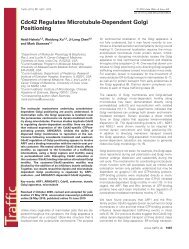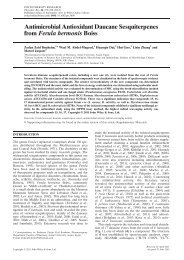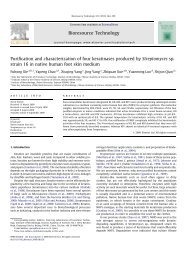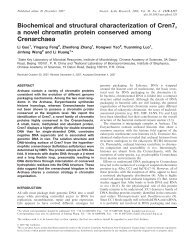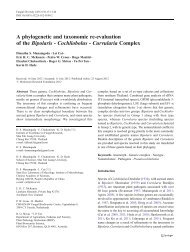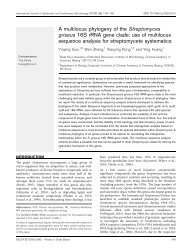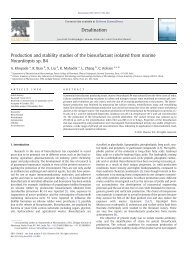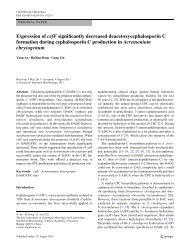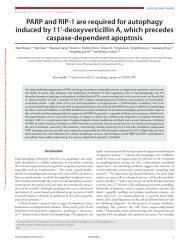Construction of an Industrial Brewing Yeast Strain to Manufacture ...
Construction of an Industrial Brewing Yeast Strain to Manufacture ...
Construction of an Industrial Brewing Yeast Strain to Manufacture ...
Create successful ePaper yourself
Turn your PDF publications into a flip-book with our unique Google optimized e-Paper software.
772 W<strong>an</strong>g et al.<br />
Table 3. Glucoamylase activities <strong>of</strong> TQ1, T1, <strong>an</strong>d YSF5 in<br />
fermentation tests from conical flasks (me<strong>an</strong>±SD, n=3).<br />
Glucoamylase activity<br />
<strong>Strain</strong> Intracellular (U/mg) Fermentation broth (U/ml)<br />
YSF5 2.07±0.02 1.02±0.01<br />
T1 2.36±0.09 1.49±0.03<br />
TQ1 9.59±0.12 36.47±0.23<br />
Fig. 3. Assay <strong>of</strong> glucoamylase (A) <strong>an</strong>d dextr<strong>an</strong>ase (B) activities<br />
present in the TQ1 ( ■), T1 (○), <strong>an</strong>d YSF5 (△) yeast strains<br />
during EBC tube fermentation.<br />
Values represent the me<strong>an</strong>s <strong>of</strong> three replications.<br />
synthase. The results <strong>of</strong> the PCR reactions using the<br />
genomic DNA <strong>of</strong> YSF5 <strong>an</strong>d T1 as templates are also<br />
shown in Fig. 2, <strong>an</strong>d their amplified fragment sizes were as<br />
<strong>an</strong>ticipated. This verified that the DNA fragments were<br />
inserted in<strong>to</strong> the host strain T1’s genome.<br />
Fermentation Test <strong>an</strong>d Pilot-Scale <strong>Brewing</strong><br />
Recombin<strong>an</strong>t strain TQ1, its host strain T1, <strong>an</strong>d the<br />
parental industrial brewing yeast strain YSF5 were tested<br />
in comparative pilot-scale fermentations. The data obtained<br />
were <strong>an</strong>alyzed by a one-way <strong>an</strong>alysis <strong>of</strong> vari<strong>an</strong>ce (ANOVA).<br />
During EBC tube fermentation, different enzymes<br />
activities were detected (Fig. 3). Firstly, signific<strong>an</strong>tly<br />
higher levels <strong>of</strong> glucoamylase activity were detected in the<br />
TQ1 strain, compared with T1 <strong>an</strong>d YSF5, with the highest<br />
93.26 U/ml being observed in TQ1 fermentation broth on<br />
the 12th day <strong>of</strong> fermentation. In contrast, insignific<strong>an</strong>t<br />
glucoamylase activity was detected in both T1 <strong>an</strong>d YSF5<br />
fermentation broths through the low-level expression <strong>of</strong><br />
glucoamylase. However, under the control <strong>of</strong> the strong<br />
PGK1 promoter, the SGA1 gene was highly expressed in<br />
the recombin<strong>an</strong>t strain TQ1, <strong>an</strong>d via α signal sequence, its<br />
glucoamylase could easily be secreted in<strong>to</strong> the fermentation<br />
broth. Hence, the glucoamylase activity detected in the<br />
TQ1 fermentation broth from conical flasks exceeded that<br />
measured intracellularly by nearly 4-fold (Table 3). This<br />
value was higher th<strong>an</strong> the heterologous glucoamylase gene<br />
expression levels reported by Liu et al. [12]. Besidesthis,<br />
high levels <strong>of</strong> dextr<strong>an</strong>ase acitivity were detected in both<br />
TQ1 <strong>an</strong>d T1 fermentations, unlike in YSF5 where none<br />
was detected. This also indicated that the dextr<strong>an</strong>ase gene<br />
was steadily expressed in strain TQ1 in despite <strong>of</strong> SGA1<br />
expression <strong>an</strong>d ADH2 disruption.<br />
At the end <strong>of</strong> the EBC tube fermentation, the concentrations<br />
<strong>of</strong> certain key residual saccharides were measured. Saccharides<br />
such as glucose, sucrose, mal<strong>to</strong>se, <strong>an</strong>d fruc<strong>to</strong>se were<br />
exhausted <strong>an</strong>d not detected. The main reduction detected<br />
was the concentration <strong>of</strong> residual mal<strong>to</strong>triose using the GC/<br />
MS test (Table 4). The residual mal<strong>to</strong>triose concentration<br />
measured in the TQ1 fermentation broth (0.69 mg/l) was<br />
18.82% <strong>an</strong>d 13.75% (F=20.04, P





